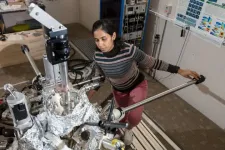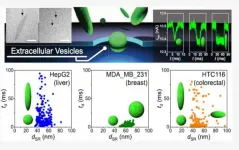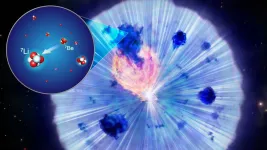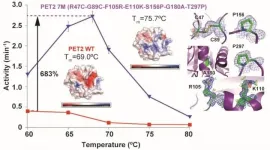(Press-News.org) Nature has a vast store of medicinal substances. "Over 50 percent of all drugs today are inspired by nature," says Gisbert Schneider, Professor of Computer-Assisted Drug Design at ETH Zurich. Nevertheless, he is convinced that we have tapped only a fraction of the potential of natural products. Together with his team, he has successfully demonstrated how artificial intelligence (AI) methods can be used in a targeted manner to find new pharmaceutical applications for natural products. Furthermore, AI methods are capable of helping to find alternatives to these compounds that have the same effect but are much easier and therefore cheaper to manufacture.
Target molecules of natural substances are potential drug targets
And so the ETH researchers are paving the way for an important medical advance: we currently have only about 4,000 basically different medicines in total. In contrast, estimates of the number of human proteins reach up to 400,000, each of which could be a target for a drug. There are good reasons for Schneider's focus on nature in the search for new pharmaceutical agents. "Most natural products are by definition potential active ingredients that have been selected via evolutionary mechanisms," he says.
Whereas scientists used to trawl collections of natural products on the search for new drugs, Schneider and his team have flipped the script: first, they look for possible target molecules, typically proteins, of natural products so as to identify the pharmacologically relevant compounds. "The chances of finding medically meaningful pairs of active ingredient and target protein are much greater using this method than with conventional screening," Schneider says.
Tested with a bacterial molecule
The ETH chemists tested their concept with marinopyrrole A, a bacterial molecule that is known to have antibiotic, anti-inflammatory and anti-cancer properties. However, there had been limited research into which proteins in the human body the natural substance interacts with to produce these effects.
To find possible target proteins of marinopyrrole A, the researchers used an algorithm they developed themselves. Employing machine learning models, the algorithm compared the pharmacologically interesting parts of marinopyrrole A with the corresponding patterns of known drugs for which the target proteins to which they bind are known. Based on the pattern matches, the researchers were able to identify eight human receptors and enzymes to which the bacterial molecule could bind. These receptors and enzymes are involved, among other things, in inflammation and pain processes and in the immune system.
Laboratory experiments confirmed that marinopyrrole A did in fact generate measurable interactions with most of the predicted proteins. "Our AI method is able to narrow down the protein targets of natural products with a reliability often in excess of 50 percent, which simplifies the search for new pharmaceutically active agents," Schneider says.
So we have the effect: now to create a cheap alternative
But the work of Schneider's research group was not over. If the findings about the target proteins of marinopyrrole A are to result in a useful treatment in the future, it is necessary to find a molecule that is easy to manufacture. After all, marinopyrrole A - like many other natural substances - has a relatively complicated structure, which makes laboratory synthesis time-consuming and expensive.
To search for a simpler chemical compound with the same effect, the ETH researchers used yet another algorithm they designed themselves. This AI program was tasked with being a "virtual chemist" and finding molecules that have similar chemical functionalities to the natural model despite having a different structure. According to the constraints of the algorithm, it also had to be possible to make the molecules in a maximum of three synthesis steps, ensuring easy, low-cost production.
New chemical structures with the same effect
To define the synthesis path, the software had access to a catalogue of over 200 starting materials, 25,000 purchasable chemical building blocks and 58 established reaction schemes. After each reaction step, the program selected as the starting material for the next step the variants that matched marinopyrrole A most closely in terms of functionalities.
In total, the algorithm found 802 suitable molecules, based on 334 different scaffolds. The researchers synthesized the best four in the laboratory and discovered that they actually behaved very similarly to the natural model. They had a comparable effect on seven of the eight target proteins identified by the algorithm.
Subsequently, the researchers investigated the most promising molecule in detail. X-ray structure analyses showed that the compter-generated compound binds to the active centre of a target protein in much the same way as known inhibitors of this enzyme. Despite its different structure, then, the molecule found by AI works using the same mechanism.
Effects on pharmaceutical research
"Our work proves that AI algorithms can be employed in a targeted manner to design active ingredients with the same effects as natural substances, but with simpler structures," Schneider says, adding: "This helps not only to manufacture new drugs, but also places us on the cusp of a potentially fundamental change in medical-chemical research." That is to say, the ETH research group's methods make it possible to find drugs that do the same things as existing drugs but are based on different structures. This could make it easier in future to design new unpatented molecular structures. There is currently intense debate regarding both the extent to which AI could be used to systematically circumvent patent protection and the possible patenting of molecules designed by "creative" AI. In any case, the pharmaceutical industry will have to adapt its research approach to a new rulebook.
INFORMATION:
Researchers at the IBS Center for Quantum Nanoscience at Ewha Womans University (QNS) have shown that dysprosium atoms resting on a thin insulating layer of magnesium oxide have magnetic stability over days. In a study published in Nature Communications they have proven that these tiny magnets have extreme robustness against fluctuations in magnetic field and temperature and will flip only when they are bombarded with high energy electrons through the STM-tip.
Using these ultra-stable and yet switchable single-atom magnets, the team has shown atomic-scale control of the magnetic field within ...
Dr Bock, under the mentorship of Distinguished Professor Dietmar Hutmacher, from QUT Centre for Biomedical Technologies, has focused her research on bone metastases from breast and prostate cancers.
She developed 3D miniature bone-like tissue models in which 3D printed biomimetic scaffolds are seeded with patient-derived bone cells and tumour cells to be used as clinical and preclinical drug testing tools.
The research team investigated their hypothesis that traditional anti-androgen therapy had limited effect in the microenvironment of prostate cancer bone tumours. The team's findings are published in Science Advances.
"We wanted to see if the therapy could be a contributor of cancer cells' adaptive responses that fuelled bone ...
A recent study by scientists from Japanese universities has shown that the shape of cell-derived nanoparticles, known as "extracellular vesicles" (EVs), in body fluids could be a biomarker for identifying types of cancer. In the study, the scientists successfully measured the shape distributions of EVs derived from liver, breast, and colorectal cancer cells, showing that the shape distributions differ from one another. The findings were recently published in the journal Analytical Chemistry.
Early detection of cancerous tumors in the body is essential for ...
New York, NY (July 6, 2021) - Mount Sinai researchers have uncovered the complex cellular mechanisms of Ebola virus, which could help explain its severe toll on humans and identify potential pathways to treatment and prevention. In a study published in mBio, the team reported how a protein of the Ebola virus, VP24, interacts with the double-layered membrane of the cell nucleus (known as the nuclear envelope), leading to significant damage to cells along with virus replication and the propagation of disease.
"The Ebola virus is extremely skilled at dodging the body's immune defenses, and in our study we characterize an important way in which that evasion occurs through disruption of the nuclear envelope, mediated by the VP24 protein," says co-senior ...
QUT PhD researcher Zachariah Schuurs said the research team had identified a new binding site on the SARS-CoV-2 spike protein.
"Binding of the CoV-2 spike protein to heparan sulphate (HS) on cell surfaces is generally the first step in a cascade of interactions the virus needs to initiate an infection and enter the cell.
"Most research has focused on understanding how HS interacts on the receptor-binding domain (RBD) and furin cleavage site of the SARS-CoV-2 virus's spike protein, as these typically bind different types of drugs, vaccines and antibodies.
"We have identified a novel binding site on the N-terminal domain (NTD), a different area of the virus's spike that facilitates the binding of HS. This helps to better understand how the virus ...
A new study of lithium production in a classical nova found a production rate of only a couple of percent that seen in other examples. This shows that there is a large diversity within classical novae and implies that nova explosions alone cannot explain the amount of lithium seen in the current Universe. This is an important result for understanding both the explosion mechanism of classical novae and the overall chemical evolution of the Universe.
In the modern world, lithium is used in the rechargeable batteries powering smartphones and other devices. ...
Cheap to produce and long to degrade, plastic was once a manufacturing miracle. Now, plastic is an environmental plague, clogging landfills and choking waterways. A Japan-based research team has turned back to nature to develop an approach to degrading the stubborn substance. Similar to how a protein binds to cellulose in plants or to chitin in crustaceans to initiate decomposition, an engineered protein is on its way to binding to plastic particles in an effort to more efficiently break them down.
They published their results on June 29 in ACS Catalysis, a journal of the American Chemical Society.
"Polyethylene ...
In two recent articles published in Schizophrenia Bulletin, Sharon Hunter, PhD, an associate professor in the University of Colorado School of Medicine Department of Psychiatry, and M. Camille Hoffman, MD, MSc, an associate professor in the University of Colorado School of Medicine Department of Obstetrics and Gynecology, along with their research group, have uncovered a potential link between choline deficiency in Black pregnant women in the United States and increased risk of developmental and behavioral issues that can evolve into mental illness later in their children's lives.
The first article, published in November 2020, is a study, titled, "Black American Maternal Prenatal Choline, Offspring Gestational Age at Birth, and Developmental Predisposition to Mental Illness." The ...
Scientists at KAIST have fabricated a laser system that generates highly interactive quantum particles at room temperature. Their findings, published in the journal Nature Photonics, could lead to a single microcavity laser system that requires lower threshold energy as its energy loss increases.
The system, developed by KAIST physicist Yong-Hoon Cho and colleagues, involves shining light through a single hexagonal-shaped microcavity treated with a loss-modulated silicon nitride substrate. The system design leads to the generation of a polariton laser at room temperature, which is exciting because this usually requires cryogenic temperatures.
The researchers found another unique and counter-intuitive feature of this design. Normally, energy is lost during laser operation. ...
Australian scientists researching how our immune system responds to COVID-19 have revealed that those infected by early variants in 2020 produced sustained antibodies, however, these antibodies are not as effective against contemporary variants of the virus.
The research is one of the world's most comprehensive studies of the immune response against COVID-19 infection. It suggests vaccination is more effective than the body's natural immune response following infection and shows the need to invest in new vaccine designs to keep pace with emerging COVID variants.
Published today in PLOS ...





